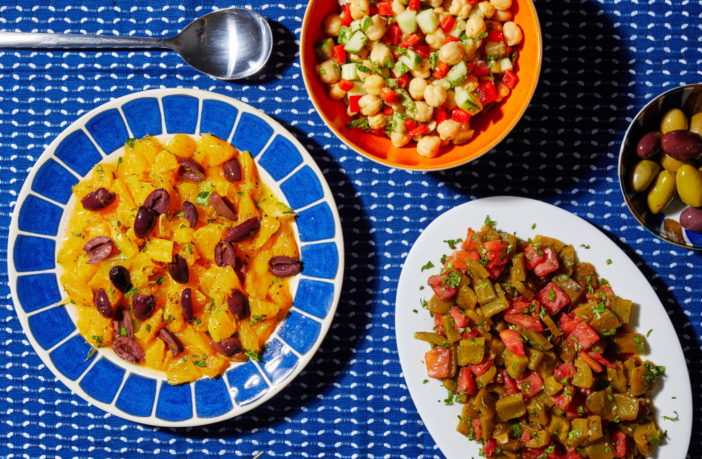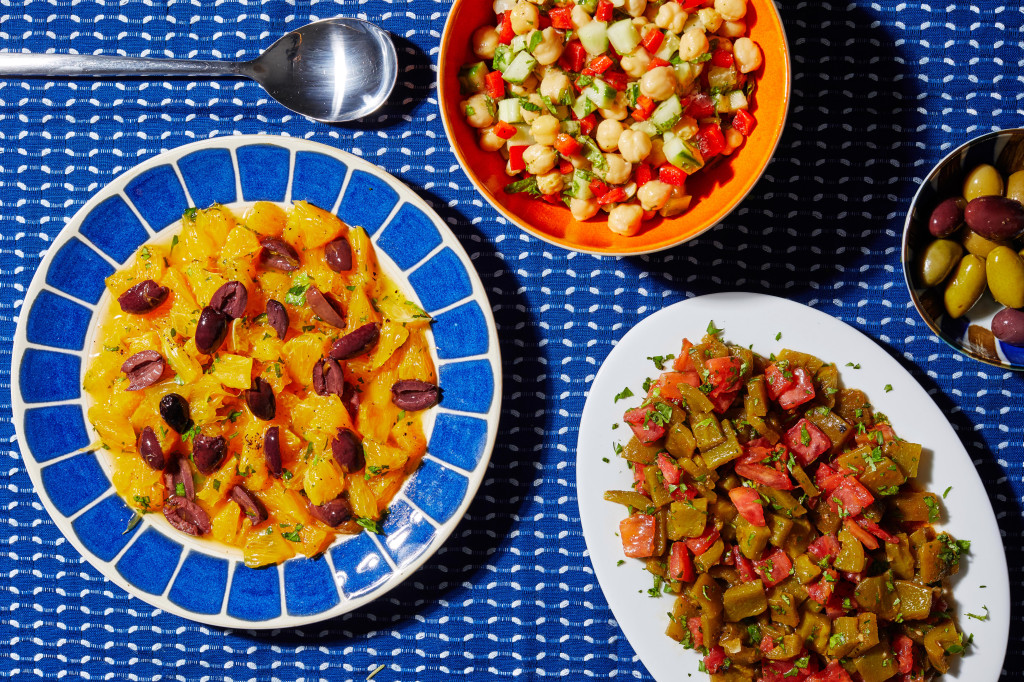SFGate
Washington Post
By Jeff Koehler
Orange Salad With Black Olives
Moroccan cuisine is colorful, sophisticated and always artfully presented. “First, we eat with the eyes,” goes one particularly telling expression.
It is also often meat-rich. Succulent slow-cooked lamb tagines with dried fruits and a heady mélange of spices (ginger, cinnamon, turmeric, sweet paprika, saffron) and chicken with preserved lemon and olives are among its signature dishes. And while “seven vegetable couscous” is something of a national dish — and does indeed include seven types of vegetables — the broth is usually flavored with meat and bones. Ditto for harira, the silky tomato, lentil and chickpea soup that many eat daily during Ramadan. Much the same can be said for numerous vegetable-dominated dishes.
Yet, especially for guests and on special occasions, it is an array of vegetarian salads that open meals — often in spectacular fashion.
The range of what a host might offer is wide and, depending on the season, can include chilled caramelized cubes of butternut squash dusted with cinnamon; mashed eggplant and tomato zaalouk with plenty of garlic and maybe some hot paprika; flame-grilled green peppers tossed with chopped tomatoes, herbs and some preserved lemon peel; and cucumbers in a sweet marinade given a scattering of dried wild thyme before serving.
[Related recipe: Flame-Grilled Green Pepper and Fresh Tomato Salad]
This course of fresh and “cooked” salads is one of the country’s most delectable culinary traditions and offers an ideal showcase not just for the cook’s ability but the cuisine’s originality. After 20 years of traveling in Morocco, I continue to be awestruck by the impressive salad spreads on the tables from the seaside capital city Rabat to Berber villages in the High Atlas to humble places in the desert south.
Or on its most exclusive. At the restaurant in the Royal Mansour, a hotel owned by King Mohammed VI that acts as something of an unofficial extension to his palace in Marrakesh, I tasted regal sophistication with salads. Dinner began one evening with seven of them, each distinct in flavor, color and texture: orange segments individually wrapped with slivers of beetroot; mashed caramelized pumpkin with plump Medjool dates from a southeastern oasis; mallow jazzed up with preserved lemons and marinated olives from the souk; and, in the tradition of persistent refinement in the palace kitchen, spinach leaves with orange blossom foam and a pinch of ground cinnamon.
While the dadas of La Maison Arabe stress fresh, seasonal ingredients when deciding on which salads to prepare, contrasts in flavors, colors and textures are also key.
To highlight this, the salad selection often includes versions that use the same principal ingredient. For instance, a dish of tangy beets with plenty of fresh cilantro and parsley might appear beside a sweet one of beets tossed with orange segments and a hint of orange blossom water.
My favorite coupling is with carrots. One classic savory salad is rounds of boiled carrots tossed with olive oil, sweet paprika and plenty of cumin. This is chilled and given a squeeze of lemon juice and a scattering of fresh flat-leaf parsley before serving. The carrot’s natural sweetness balances the bold and earthy punch of spice. Ideally, beside it comes a bowl of grated raw carrots steeped in freshly squeezed orange juice, garnished with raisins then given a dash of orange blossom water and a pinch of ground cinnamon for aroma. The texture has a pleasing crunch, and the flavors are fresh and fruity. (To continue the playful combination, beside it might be a plate of orange segments tossed in oil — olive, walnut or even Moroccan argan — and garnished with black olives.)
[Related recipe: Chickpea Salad With Red Pepper, Cucumber and Mint]
Whenever possible, I have a whole meal of these salads. With some of the country’s traditional round loaves of bread, there are few things I would prefer for lunch or dinner when traveling in Morocco.
Or even back home. I like to prepare a half-dozen salads to savor over several days, either together for light meals with bread or as sides to something heavier.
Like many families, we tend to entertain more in the summer, and light the grill when there is a crowd. On such occasions, my go-to choice for dinner is a wide array of Moroccan salads to accompany whatever protein we choose. A range of sweet and savory salads always pair well, no matter if we grill fresh sardines, skewers of marinated chicken or lamb chops. Everyone is sure to like at least a couple of the salad options, and they equally satisfy our vegetarian and non-vegetarian guests.
For the uninitiated, there is also festive pleasure in discovering these original flavor combinations. Tasting carrots and orange juice for the first time, or oranges with a savory oil and black olives, is pure joy.
While the eyes might be the first to feast on the colorful array of salads on the table, the palate follows soon after. And the pleasures of the palate are even greater with these salads.
Orange Salad With Black Olives
Nutty-flavored oils, such as walnut, hazelnut or, ideally, Moroccan argan — pressed from the seeds of a spiny tree native to southwestern Morocco and commonly found in health and beauty products — beautifully highlight the light citrus flavors in this salad. Be sure to use a culinary argan oil.
2 navel or Valencia oranges
1 1/2 tablespoons extra-virgin olive oil (may substitute walnut, hazelnut or culinary argan oil; see headnote)
2 teaspoons minced fresh flat-leaf parsley
Kosher salt or sea salt
Freshly ground black pepper (optional)
16 black olives, pitted and cut in half (preferably oil-cured Moroccan olives; may substitute kalamata)
Step 1
Trim off the top and bottom ends of the oranges and reserve. Using a paring knife, remove the orange peel, along any of the white pith. Cut the orange crosswise into 1/2-inch-thick slices. Over a large bowl, pull the segments into triangular pieces and then drop into the bowl. Squeeze the reserved ends into the bowl as well.
Step 2
Drizzle the oil over the oranges, then add the parsley, and season lightly with salt and, if using, pepper. Toss gently to combine. Cover and refrigerate until chilled, about 1 hour. Before serving, toss again and garnish with the olives.
Koehler is the author of numerous books, including, “Morocco: A Culinary Journey with Recipes from the Spice-Scented Markets of Marrakech to the Date-Filled Oasis of Zagora” (Chronicle Books, 2012).
Tested by Barbara Strack; email questions to voraciously@washpost.com.
Scale and get a printer-friendly version of the recipe here.
Did you make this recipe? Take a photo and tag us on Instagram with #eatvoraciously.
NUTRITION
Calories: 100; Total Fat: 8 g; Saturated Fat: 1 g; Sodium: 150 mg; Carbohydrates: 10 g; Dietary Fiber: 2 g; Sugars: 6 g.
PAID PROMOTED STORIES
-
1This fresh tomato sauce is rich, flavorful and yours in under an hour
-
2What should you keep in your freezer? Rachael Ray, Christopher Kimball and more experts weigh in
-
3Love it or hate it, oak is important in wine. Here are 5 things to know.
-
4Ricotta toast with peaches and pistachios is the summer snack you didn’t know you needed
-
5Need a golden brown chicken schnitzel that’s crispy without being greasy? This is it.

















